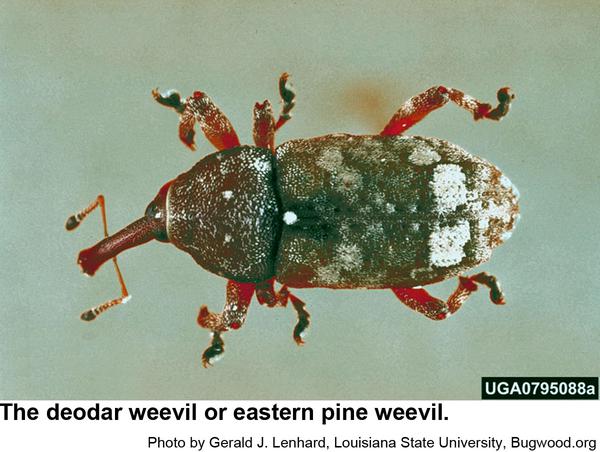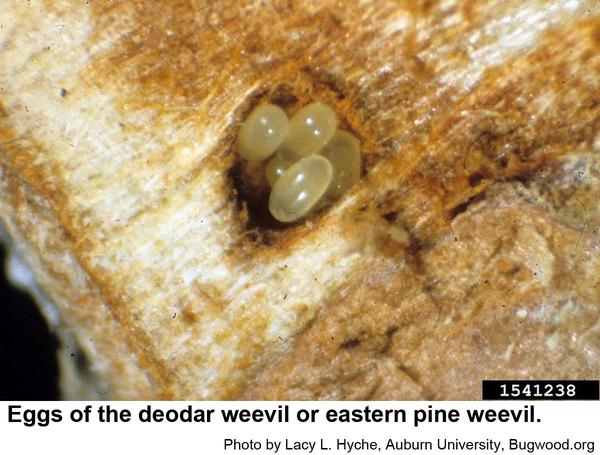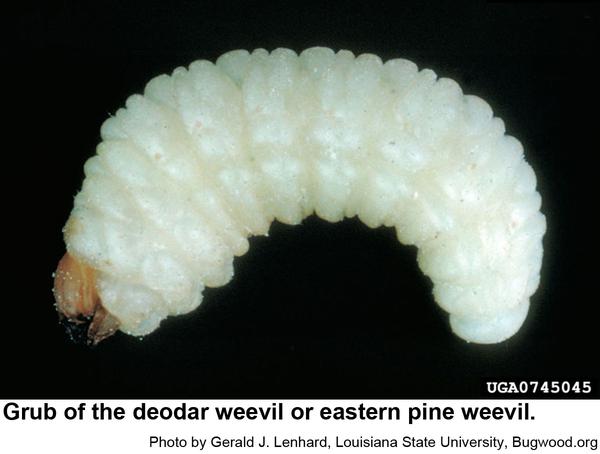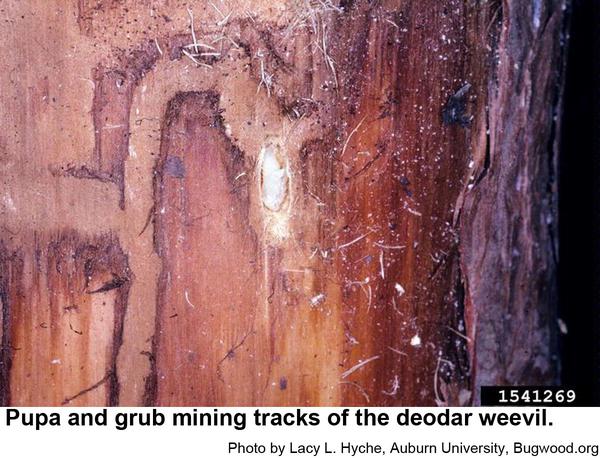Description and Biology
Deodar weevils, Pissodes nemorensis, are also called also called eastern pine weevils. They are oval and brown to black beetles with a pronounced snout. The thorax has two very small but distinct white spots. Another distinct spot occurs at the base of the wings (the sutellum), and two large white spots occur closer to the rear of the wings. The eggs are plump ovals and are very small. Newly hatched grubs bore under the bark where they feed, molt, and grow. The grubs eventually grow into plump, white, curved insects with brown heads and no legs. Eventually grubs construct a chip cocoon inside of which they pupate in late winter or very early spring. Pupae are white, peculiar forms but the proboscis is well formed. The legs are crumpled beneath the proboscis, wing pads are wrapped around the thorax, and the head has low spines. Pupae darken as their time to molt approaches. Adult weevils begin emerging in March but most of the new adult weevils emerge in May (small circular escape holes are sometimes noticed on infested stems). The new weevils apparently aestivate during the summer and become active as the weather cools down in the fall when they infest stressed trees, feed and mate. The weevils are active all winter long and lay one to four or five eggs in the inner bark in holes chewed through the bark, but fall is the peak time for adult feeding and breeding. The weevils do some minor damage as they feed on the bark before laying their eggs. There is one generation per year.
Host Plants
Deodar weevils infest almost all pine species in the eastern United States as well as Douglas-fir and all spruces. Deodar weevils usually don't infest trees younger than age 5 (they need stems large enough to support larval galleries). Deodar weevils tend to infest the bottom 10 feet of the main stem. These weevil grubs feed beneath the bark and sometimes girdle the stem causing it to die from the damaged portion outward. The bark may swell over the feeding areas. Deodar weevils have killed trees up to 36 feet tall as the weevils attack the lower trunk. Infested shoots may die, causing excessive branching. In addition, deodar weevils can vector pitch canker (Fusarium moniliforme).
Residential Recommendations
Pines have natural defenses that effectively prevent deodar weevil attacks when trees are healthy and growing rapidly, but during late summer droughts, attacks can be as devastating. The primary method of control is to maintain tree vigor, especially consider irrigating specimen trees during prolonged dry spells. The next best method of controlling deodar weevils is by using a pesticide especially in the fall as the weevils become active again. If the weevils are in the area, it would be a good idea to spray specimen trees in April or May as well. Consider using one of the pyrethroids because pyrethroids are very toxic to insects but are not particularly hazardous to humans and pets (other than fish - avoid using pyrethroids around pools, ponds, and streams) when used as directed. Pyrethroids labeled for residential landscape use are readily available in most big box stores, plant centers, and nurseries. The active ingredient of all pesticides are listed on the front label usually in very small font near the bottom. The active ingredient of pyrethroids ends with "-thrin." Most pyrethroids have a long residual life in the environment so one treatment should protect the plant for several weeks.
Other Resources
- Deodar Weevil. Anonymous. No Date. Alabama Forestry Commission.
- Insects of Eastern forests. Drooz, A. T. editor. 1985. USDA Forest Service Misc. Publication 1426. 608 pp.
- Pissodes nemorensis. Ellis, H. C. 2010 (modified). BugwoodWiki. Center for Invasive Species and Ecosystem Health at the University of Georgia.
- What Is Attacking My Pine? The Case of the Deodar Weevil. Self, B. 2020 (copyright). Mississippi State University Extension Publication Number: P3057.
- NC State Extension Plant Pathology Publications
- NC State Horticultural Science Publications
- North Carolina Agricultural Chemicals Manual
For assistance with a specific problem, contact your local Cooperative Extension center.
This factsheet has not been peer reviewed.
Publication date: July 28, 2020
Reviewed/Revised: May 8, 2025
Recommendations for the use of agricultural chemicals are included in this publication as a convenience to the reader. The use of brand names and any mention or listing of commercial products or services in this publication does not imply endorsement by NC State University or N.C. A&T State University nor discrimination against similar products or services not mentioned. Individuals who use agricultural chemicals are responsible for ensuring that the intended use complies with current regulations and conforms to the product label. Be sure to obtain current information about usage regulations and examine a current product label before applying any chemical. For assistance, contact your local N.C. Cooperative Extension county center.
N.C. Cooperative Extension prohibits discrimination and harassment regardless of age, color, disability, family and marital status, gender identity, national origin, political beliefs, race, religion, sex (including pregnancy), sexual orientation and veteran status.






